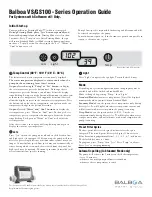
Page
9
of
16
thermocouple
or
aeration
hole.
Use
only
genuine
spare
parts
as
similar
looking
parts
from
other
appliances
may
well
give
different
or
inferior
performance
and
could
lead
to
a
hazard.
10.6
Firefronts
The
design
of
these
affect
combustion,
therefore
only
the
correct
front
supplied
with
the
appliance
may
be
fitted.
10.7
Fireguards
A
fireguard
is
not
supplied
with
this
appliance;
however
it
is
recommended
that
a
fireguard
to
BS6539
or
BS6778
is
fitted
if
the
fire
is
to
be
used
in
the
presence
of
young
children,
the
elderly
and
the
infirm.
10.8
Completion
of
Warranty
Card.
The
installer
section
of
the
guarantee
card
must
be
filled
in
fully
to
validate
the
warranty.
I.e.
pressure,
model,
room
size
and
Gas
Safe™
registered
installer
(formerly
CORGI)
Number
11.
SERVICING
INSTRUCTIONS
As
with
all
gas
appliances
the
unit
must
be
serviced
at
least
once
per
year,
preferably
at
the
beginning
of
the
heating
season.
All
servicing
must
be
carried
out
by
a
qualified
service
person.
Before
commencing
any
servicing,
ensure
that
the
gas
is
turned
off
to
the
appliance
and
that
the
appliance
is
cool.
Cleaning
–
If
required
the
casing
should
be
wiped
with
a
cloth
dampened
in
soapy
water.
The
glass
may
be
cleaned
with
any
non
‐
abrasive
cleaner
such
as
‘hob
brite‘.
Lift
the
cast
front
and
the
decorative
frame
to
remove.
Unscrew
the
four
nuts
holding
the
glass,
remove
and
place
thoughtfully
to
avoid
damage
or
injury.
Carefully
remove
the
front
and
rear
coal
sets
and
clean
the
burner
and
associated
parts
using
a
vacuum
cleaner.
Take
particular
care
to
remove
all
debris
around
the
pilot
light.
The
logs
and
backing
‘brickwork’
contain
refractory
fibre
(RCF).
Excessive
exposure
to
these
materials
may
cause
temporary
irritation
to
the
eyes,
skin
and
respiratory
tract;
consequently,
it
makes
sense
to
take
care
when
handling
these
parts
to
ensure
that
the
release
of
dust
is
kept
to
a
minimum.
We
recommend
the
use
of
a
HEPA
filtered
vacuum
to
remove
any
dust
and
soot
accumulated
in
the
heater
before
and
after
working
on
it.
When
replacing
these
articles,
they
should
not
be
broken
up,
but
sealed
in
heavy
duty
polythene
bags
labelled
‘RCF
Waste’,
which
may
be
disposed
of
at
a
tipping
site
licensed
for
industrial
waste.
Normal
hygiene
rules
of
not
smoking,
eating
or
drinking
in
the
work
area
should
be
followed.
Disconnect
the
gas
supply
to
the
appliance.
Undo
the
two
nuts
holding
the
burner
assembly
in
the
chassis.
Remove
the
burner
tray
and
examine
it
for
general
condition.
Discoloration
of
the
burner
surface
is
normal.
Clean
around
the
air
inlet,
removing
all
lint
in
the
area
of
the
injector
and
ensuring
the
pilot
light
aeration
hole
and
flame
head
are
clean.
Injectors
–
Only
original
manufacturer’s
injectors
must
be
used.
Identification
is
as
follows:
Natural
Gas
(G20
/
G25)
‐
92/300
Propane
(G31)
‐
92/90
should
the
oxypilot
system
need
to
be
replaced,
the
original
manufacturer’s
parts
must
be
used.
Controls
–
The
GAS
CONTROL
IS
FACTORY
SET
AND
NORMALLY
NEEDS
NO
ADJUSTMENT.
Check
for
smooth
operation
of
the
gas
valve.
Remove
all
covers;
check
the
tightness
of
the
thermocouple
connection
into
the
valve,
the
condition
of
the
piezo
and
ignition
leads.
Examine
the
fire
casing,
the
firebox
and
catalytic
converter
for
obvious
signs
of
damage
or
degradation.
Clean
out
any
dirt
or
dust
accumulated
in
the
bottom
of
the
fire.
Reassemble
in
reverse
order.
Replace
burner
into
chassis
and
reconnect
to
the
gas
supply.
Test
all
joints
for
leaks.
Following
the
manufacturer's
instructions,
re
‐
lay
the
fuel
bed
and
replace
the
glass.


































